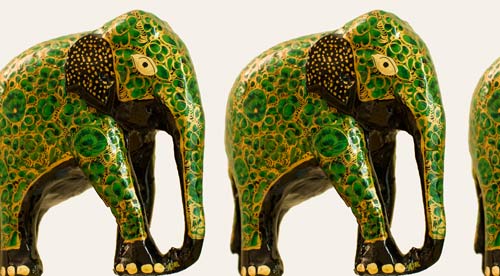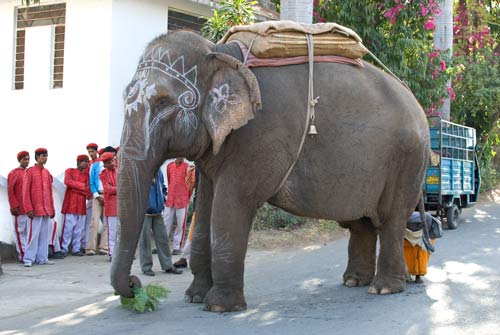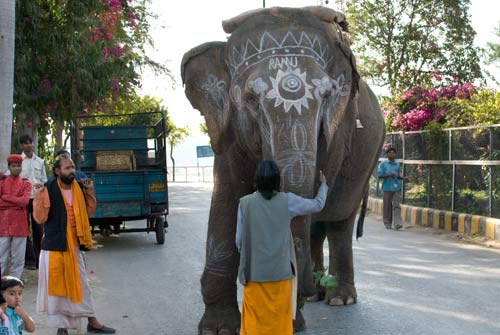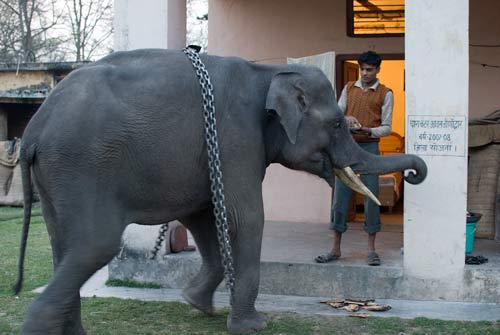
Seeing Elephants
Spotting elephants walking in the road is not the norm for a Western woman like myself.
However, I am happy to say that I have now experienced that phenomenon in India.
Marriage Partners
Getting married in India means that the bride’s family gets out the great guns, and that is what led to my first sighting of an Asian elephant swaying down a neighborhood street.
Made up for the occasion with white markings on her face and body, she was accompanied on a street in Udaipur by a group of musicians decked out in red and white.
Gracing The City of Lakes
Also known as the romantic ‘City of Lakes’, Udaipur is located in the state of Rajasthan in western India and its ambiance provides a lovely setting for tying the knot.
So although the bride and groom were not on the scene yet, these other participants were there in anticipation of the big event.

Standing back a bit in the street, David took another shot of her being given a pep talk by her handler. As you can see, her name is Ranu. And as her handler explained to us, she was wonderfully decorated to participate in the wedding festivities.

Seeing A Mom And Baby From An Open Jeep
Several weeks after this, I spotted elephants on the path beind us – but this time it was from the back of an open jeep. I had never traveled about in such a vehicle before, which made eyeing pachyderms all the more fun from its vantage point.
The setting this time was in Rajaji National Park. The park is a tranquil area of scrub and forest covering about 300 square miles (800 square km) in the foothills near the holy town of Haridwar, which is located where the Ganges becomes visible as it flows down from the Himalayas.
As you can see, this time what I saw was an Asian elephant mom and baby out for a stroll in the middle of a lovely afternoon:

Lucking Out
There were four of us in the jeep that day – David, our guide, another man visiting the park, and myself.
The weather was sunny and mild. Besides being fortunate with the weather, at the end of our ride our guide told us we had also lucked out because we had seen about fifteen wild elephants besides this pair.
Wet Versus Dry
Apparently many people go to the park in search of elephants but they never see any. Our guide explained that this is especially true when there has been rain.
Why is this so? Because when it’s dry, the elephants in the park congregate at waterholes. The guides know those waterholes, and so they can drive tourists straight to them.
However, when it rains, the elephants can drink from many areas in the park.
That is why we were doubly lucky to see elephants as we did because it had rained just the day before.
Spotting A Woebegone Fellow
Through his binoculars (and too far away to be photographed), David also saw a makna, as the perpetually sexually frustrated elephant is called.
David called the animal to the rest of us in the jeep, whereupon we all leaped for our own binoculars to view the poor creature.
Maknas – Unfortunate Elephants Who Never Mate
Now why are maknas in such a sad state, you may wonder?
Well, maknas are bull elephants without tusks. Because of this, female elephants find them unappealing and they will not mate with them.
To rub salt into the wound, these poor maknas have the unfortunate distinction of always being in must.
What Being In Must Means to Elephants
During must, the temporal glands of adult male elephants become swollen. They exude a strong-smelling liquid that is rich in testosterone, and this liquid runs in rivulets down the sides of their heads. The must is, of course, designed to attract female elephants.
Males are very aggressive as well as being sexually active during this must season.
How Maknas Exhibit Signs Of Perpetual Must
For the maknas, must never ends and they never mate. Perhaps one saving grace is that many Indian mahouts (elephant trainers) believe that maknas have a milder form of must than tuskers (male elephants with tusks) do.
You can tell a makna because he’s large like his fellow tuskers but without the tusks. You can also spot the potent fluid running in rivulets from the gland on the side of their head as we did during our visit to Rajaji National Park.
No Relief In Sight
Because maknas are noted for being dangerous because they are always suffering from their rampaging hormones from which they get no relief, our guide went into alert mode and readied our jeep into gear so he could reverse out of danger.
Luckily the makna did not come any nearer to us, and instead he continued on his way.
Teatime, Elephant Style
At the end of our tour, our guide took us to visit his relatives who lived just outside the boundaries of the park.
They had several rescue elephants whom we had the pleasure of seeing, including this tusker who was having an early evening snack consisting of a pile of whole wheat flat bread called ‘roti’.

Elephant Destinies
This animal seemed happy with his lot, which gladdened our hearts since we had felt so bad for the sad-looking makna whom we had seen less than an hour beforehand.
And so once again we saw how life does not deal a fair hand to everyone, including in the Asian elephant world in India into which we had had some fascinatingly diverse glimpses.